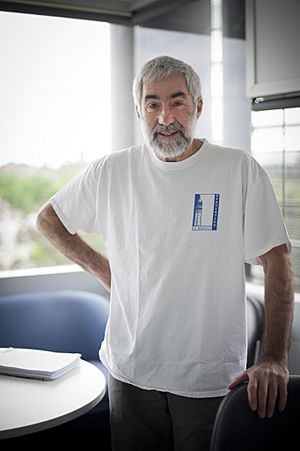Terry Speed facts for kids
Quick facts for kids
Terry Speed
|
|
|---|---|
 |
|
| Born |
Terence Paul Speed
14 March 1943 |
| Citizenship | Australia |
| Alma mater | Monash University (PhD) |
| Spouse(s) |
Freda Elizabeth (Sally) Pollard
(m. 1964) |
| Awards |
|
| Scientific career | |
| Fields | |
| Institutions |
|
| Thesis | Some topics in the theory of distributive lattices (1968) |
| Doctoral advisor | Peter D. Finch |
| Doctoral students |
|
Terence Paul "Terry" Speed (born 14 March 1943) is an Australian statistician. He is a senior research scientist at the Walter and Eliza Hall Institute of Medical Research. Terry Speed is well-known for his work in bioinformatics, especially for helping to understand microarray data.
Contents
Early Life and Learning
Terry Speed was born in Victor Harbor, South Australia. He grew up in Melbourne. In 1961, he started studying medicine and science at the University of Melbourne.
He later decided to focus only on science. In 1964, he earned an honors degree in mathematics and statistics. Terry Speed completed his Ph.D. at Monash University in 1968. His research was about a math topic called "distributive lattices."
Terry Speed's Career
After getting his PhD, Terry Speed became a lecturer in Sheffield, United Kingdom. He taught at the Manchester-Sheffield School of Probability and Statistics. In 1974, he moved back to Australia.
He became an assistant professor at the University of Western Australia. There, he led the statisticians in the mathematics department. He became a full professor in 1975 and head of the department in 1982. In 1984, Terry Speed became the chief of the mathematics and statistics division at CSIRO. CSIRO is a big science organization in Australia.
Working in the United States
In 1984, Terry Speed visited the University of California, Berkeley in the United States. He liked it so much that he applied for a permanent job there. By 1987, he became a tenured professor at the university.
In 1996, Suzanne Cory, who was the director of the Walter and Eliza Hall Institute of Medical Research (WEHI) in Melbourne, invited him to start a bioinformatics group. She had been a high-school classmate of his. Starting in 1997, he worked part-time at both the University of California, Berkeley, and WEHI.
Full-Time at WEHI
In 2009, he retired from the University of California, Berkeley. However, he continued to work with the university on research projects. This included helping PhD students and postdocs. He then started working full-time at WEHI.
At WEHI, he led the Bioinformatics division until August 31, 2014. He has continued to be a laboratory head there since then. He also helped judge the Mathematical Sciences jury for the Infosys Prize in 2009 and 2010. Terry Speed has guided at least 72 research students during his career.
Important Scientific Work
Terry Speed has worked on many different science topics. These include distributive lattices, ring theory, and analysis of variance. He is especially known for his work in bioinformatics. This field uses computer science to understand biological data.
He is very famous for helping to analyze microarray data. Microarrays are tools used in biology to study many genes at once. His work helped scientists understand what this data means.
Expert Advice
Terry Speed has also used his knowledge to help in legal cases. He has acted as an expert witness. This means he provides scientific information to help courts understand complex facts.
Awards and Special Recognitions
Terry Speed has received many awards for his scientific contributions. In 1989, he was chosen as a Fellow of the American Statistical Association. He was also the president of the Institute of Mathematical Statistics in 2004.
In 2002, he received the Pitman medal. In 2009, he was given a NHMRC Australia Fellowship. On October 30, 2013, he received the Australian Prime Minister's Prize for Science. This is a very important award in Australia.
In 2013, Terry Speed was also elected a Fellow of the Royal Society (FRS) of London. This is a very high honor for scientists. His nomination mentioned that he is seen as a top expert in analyzing microarray data. It also noted his ability to work closely with other scientists. This helps him understand real-world biology problems.
His work has also helped with newer technologies like DNA sequencing. He has also made important contributions to statistical genetics, graphical models, and Bayes networks.
Personal Life
Terry Speed married Freda Elizabeth (Sally) Pollard in 1964.

